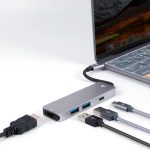USB hubs are vital for video editors like you. They connect multiple devices, making it easy to manage cameras, hard drives, and audio interfaces, which streamlines your workflow. Look for hubs with multiple ports, fast data transfer rates, and power delivery support to keep your devices charged. Whether you choose powered or unpowered hubs, the right setup enhances your productivity. Want to discover more about optimizing your USB hub experience? There's plenty more to explore!
Table of Contents
Key Takeaways
- USB hubs simplify access to multiple devices, enhancing efficiency in video editing by reducing cable switching.
- Look for hubs with a variety of ports and fast data transfer rates for maximum compatibility and speed.
- Powered hubs offer stable power for demanding devices, while unpowered hubs are lightweight and portable for editing on the go.
- Choose a compact design with sufficient ports and durable materials to withstand frequent use and ensure longevity.
- Stay updated on USB technology trends, such as USB 4.0, which offers faster speeds and improved power delivery for seamless editing experiences.
The Importance of USB Hubs in Video Editing
When you're deep into video editing, having the right tools at your fingertips is crucial, and that's where USB hubs come into play.
These devices connect multiple peripherals, like cameras, hard drives, and audio interfaces, streamlining your workflow. By expanding your USB ports, you can easily access everything you need without constantly switching cables.
USB hubs connect multiple devices, simplifying access to cameras, hard drives, and audio interfaces for a seamless editing experience.
This efficiency lets you focus on your editing rather than managing connections. Plus, with a reliable USB hub, you can transfer large files quickly, which is vital in a fast-paced environment. You won't waste time waiting for uploads or downloads.
In short, USB hubs simplify your setup, enabling you to enhance your productivity and create outstanding content more effectively.
Key Features to Look for in a USB Hub
When choosing a USB hub, you need to consider the variety and speed of its ports.
Look for a hub that supports multiple formats to accommodate your devices and offers fast data transfer rates.
Power delivery support is also essential, ensuring your gear stays charged while you work.
Port Variety and Speed
A good USB hub for video editors should offer a variety of ports and impressive speed to keep your workflow seamless.
Look for hubs that include multiple USB-A and USB-C ports, as well as HDMI or DisplayPort connections for external displays. This variety allows you to connect cameras, external drives, and monitors simultaneously, which is crucial during editing sessions.
Speed is equally important; choose a hub that supports USB 3.0 or higher to ensure fast data transfer rates. This way, you won't waste time waiting for files to transfer or render.
In short, a well-rounded hub with diverse ports and high-speed capabilities can significantly enhance your editing efficiency and overall productivity.
Power Delivery Support
While you're navigating the demands of video editing, having a USB hub that supports power delivery can make a significant difference.
This feature allows you to charge your devices while transferring data, ensuring you stay connected and productive.
Here are four key aspects to consider when looking for a USB hub with power delivery support:
- Power Output: Check for a hub that offers sufficient wattage (at least 60W) to charge your laptop or other high-demand devices effectively.
- Compatibility: Ensure it works with your devices, including laptops, tablets, and smartphones.
- Port Availability: Look for multiple power delivery ports to charge several devices at once.
- Cable Quality: Choose a hub with a durable, high-quality cable to prevent charging issues.
Investing in the right hub can streamline your editing workflow!
Types of USB Hubs: Which One Is Right for You?
When choosing a USB hub, it's important to consider whether you need a powered or unpowered model.
Think about the types of ports and speeds that will best support your video editing setup, along with how much portability you require.
Each option has its advantages, so let's explore which one fits your needs best.
Powered vs. Unpowered Hubs
Understanding the differences between powered and unpowered USB hubs can significantly impact your video editing workflow.
Here's what you need to consider when choosing between the two:
1. Power Supply: Powered hubs come with their own power source, ensuring stable power for multiple devices.
Unpowered hubs rely on your computer's power, which can lead to insufficient power for high-demand devices.
2. Device Compatibility: If you're connecting multiple hard drives or peripherals, a powered hub is essential.
Unpowered hubs work better for low-power devices like mice or keyboards.
3. Performance: Powered hubs typically offer better data transfer speeds and reliability.
4. Portability: Unpowered hubs are lighter and easier to carry, making them great for on-the-go editing.
Choose wisely to enhance your editing experience!
Port Types and Speeds
Choosing the right USB hub involves knowing the various port types and their speeds, as these factors can directly affect your video editing efficiency.
USB 3.0 and USB 3.1 ports are ideal for video editing, offering faster data transfer rates of up to 5 Gbps and 10 Gbps, respectively. These speeds minimize lag when transferring large files, such as high-resolution video footage.
If you're working with external drives or 4K monitors, opt for hubs with USB-C ports, which support Thunderbolt 3 for even higher speeds.
Also, consider USB-A ports for compatibility with older devices.
Ultimately, selecting a hub with the right mix of ports and speeds ensures a smoother workflow, allowing you to focus on your creative projects.
Size and Portability Considerations
Size and portability are crucial factors to consider when selecting a USB hub for video editing. You want a hub that can easily fit into your bag without adding unnecessary weight.
Here's what to keep in mind:
- Compact Design: Look for hubs that are sleek and lightweight, perfect for on-the-go editing.
- Durability: Choose materials that withstand daily wear and tear, ensuring longevity during your travels.
- Cable Management: Some hubs come with integrated cables, reducing clutter and making setup a breeze.
- Number of Ports: Ensure it has enough ports to accommodate all your essential devices without sacrificing space.
Top USB Hubs for Video Editors in 2023
As a video editor in 2023, having the right USB hub can make all the difference in your workflow.
The Anker PowerExpand Elite is a top choice, offering multiple USB-C and USB-A ports along with 85W charging capabilities.
The Anker PowerExpand Elite excels with its multiple ports and impressive 85W charging capabilities, making it a top pick for video editors.
If you need something compact, check out the HyperDrive Duo, which fits perfectly with MacBook devices and provides essential ports without taking up much space.
For those on a budget, the Sabrent 4-Port USB Hub delivers reliable performance at an affordable price.
Finally, the CalDigit TS3 Plus stands out for its versatility, featuring a variety of connections, including Thunderbolt 3 support.
Choose a hub that suits your editing style, and you'll streamline your projects significantly.
How to Set Up Your USB Hub for Maximum Efficiency
Setting up your USB hub for maximum efficiency can significantly enhance your editing workflow. Follow these steps to get the most out of your hub:
- Prioritize Ports: Assign specific devices to each port based on usage frequency. Keep your most-used devices easily accessible.
- Use Short Cables: Shorter cables reduce clutter and improve data transfer speeds, keeping your workspace tidy.
- Label Connections: Use labels for each cable or device to quickly identify connections, saving you time during busy editing sessions.
- Position Strategically: Place your hub within arm's reach to minimize unnecessary movements while working, helping you maintain focus and productivity.
Troubleshooting Common USB Hub Issues
When your USB hub isn't functioning properly, it can disrupt your entire editing process, leaving you frustrated and unable to work efficiently.
First, check the power supply; some hubs need external power to function correctly. If it's powered, inspect the connections. Unplug and replug your devices to ensure a secure fit.
Check the power supply and connections; a secure fit is essential for your USB hub to function properly.
Next, try using different ports on your computer. Sometimes, specific ports may fail or have insufficient power.
If you're still having issues, test with another device to isolate the problem. Updating your drivers can also resolve compatibility issues.
Lastly, if your hub's lights aren't on or flickering, it may be time to consider a replacement. Regular maintenance can help avoid these frustrations in the future.
Future Trends in USB Hub Technology for Video Editing
With the rapid pace of technological advancement, the future of USB hub technology is poised to revolutionize video editing workflows.
As a video editor, you'll benefit from innovations that enhance speed and efficiency. Here are some trends to watch for:
- Faster Data Transfer: USB 4.0 will dominate, offering higher bandwidth for quick file transfers.
- Power Delivery: Expect hubs that can charge multiple devices simultaneously while maintaining data transfer.
- Integrated Storage Solutions: Look for hubs incorporating SSDs, giving you immediate access to your footage.
- Smart Hubs: AI-driven features will optimize device connectivity and manage power distribution intelligently.
Embracing these advancements will help you streamline your editing process and keep pace with evolving technology.
Frequently Asked Questions
Can USB Hubs Improve Video Editing Performance?
Yes, USB hubs can definitely improve your video editing performance. They allow you to connect multiple devices simultaneously, reducing downtime and enabling smoother data transfers. This efficiency can enhance your overall editing experience significantly.
Are Powered USB Hubs Necessary for Video Editing?
Powered USB hubs aren't strictly necessary for video editing, but they can enhance performance. They provide extra power for multiple devices, reducing lag and ensuring smooth data transfer, so you might find them beneficial.
How Many Devices Can I Connect to a USB Hub?
You can typically connect anywhere from 4 to 10 devices to a USB hub, depending on its design and power capacity. Always check the specifications to ensure it meets your needs for connectivity.
Do USB Hubs Affect Data Transfer Speeds?
Yes, USB hubs can affect data transfer speeds. When multiple devices are connected, they share bandwidth, which might slow down individual transfer rates. It's essential to choose a high-quality hub for better performance.
Can I Use a USB Hub With Different Computer Brands?
Yes, you can use a USB hub with different computer brands. Most hubs are designed to be universal, allowing you to connect devices across various systems without compatibility issues. Just ensure your hub meets your needs.




